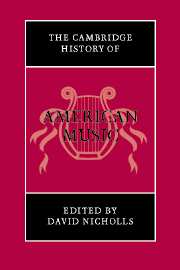Book contents
- Frontmatter
- PART ONE
- PART TWO
- 10 Music in America: an overview (part 2)
- 11 Immigrant, folk, and regional musics in the twentieth century
- 12 Popular song and popular music on stage and film
- 13 The rock and roll era
- 14 Ragtime and early jazz
- 15 Jazz from 1930 to 1960
- 16 Jazz since 1960
- 17 Tonal traditions in art music from 1920 to 1960
- 18 Serialism and complexity
- 19 Avant-garde and experimental music
- 20 Tonal traditions in art music since 1960
- Bibliography and references
- Index
- References
20 - Tonal traditions in art music since 1960
from PART TWO
Published online by Cambridge University Press: 28 March 2008
- Frontmatter
- PART ONE
- PART TWO
- 10 Music in America: an overview (part 2)
- 11 Immigrant, folk, and regional musics in the twentieth century
- 12 Popular song and popular music on stage and film
- 13 The rock and roll era
- 14 Ragtime and early jazz
- 15 Jazz from 1930 to 1960
- 16 Jazz since 1960
- 17 Tonal traditions in art music from 1920 to 1960
- 18 Serialism and complexity
- 19 Avant-garde and experimental music
- 20 Tonal traditions in art music since 1960
- Bibliography and references
- Index
- References
Summary
If the history of American music in the twentieth century can be said to have imparted at least one clear lesson, it is that tonality has proved to be a far more durable and resilient force than many, at least among the more progressively minded, would ever have predicted at the century’s beginning. Indeed, although there is still an identifiable musical avant garde, and although prominent figures in modernism’s second (post-World War II) wave, such as Milton Babbitt and Elliott Carter, are still making their voices heard, it is tonality in all its many varieties that seems poised to set the tone, as it were, for the concert music of ad 2000 and beyond. Among those performers and audiences with at least some interest in recently composed music, it is tonal music especially during the last two decades that has garnered the lion’s share of attention. Elderly composers who grew up neoclassical and never wavered; middle-aged composers who started off as atonalists or dodecaphonists only to repent later on; and younger composers for whom a nontonal idiom was never really a viable or seriously considered option – all are enjoying exposure in performances and recordings as never before.
Why has this happened? And why now? For all its history as a melting pot, open to new influences of every sort, America has, paradoxically, always had a deeply conservative streak. And this conservatism is nowhere more evident than in its attitude toward the arts. As has often been pointed out, the Þrst Caucasian arrivals in the territories that eventually became the United States, as well as the many succeeding waves of immigrants over the next several centuries, brought what “culture” they had from their former, European homelands.
- Type
- Chapter
- Information
- The Cambridge History of American Music , pp. 535 - 566Publisher: Cambridge University PressPrint publication year: 1998

